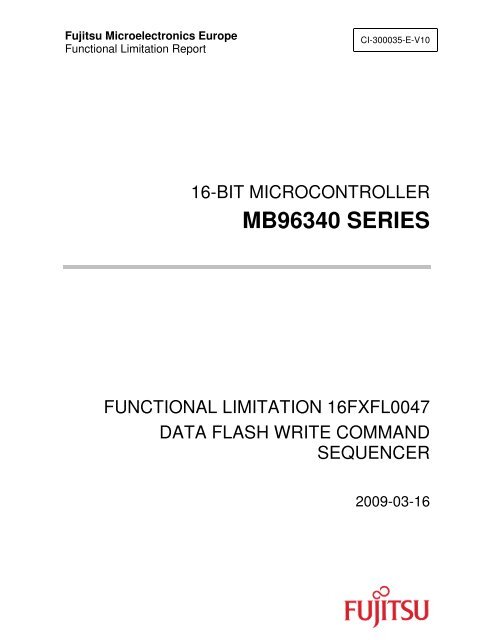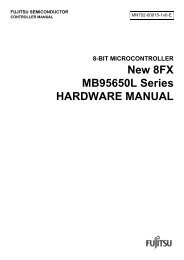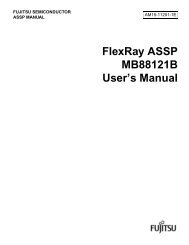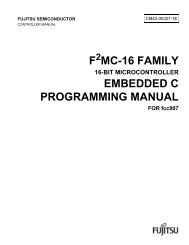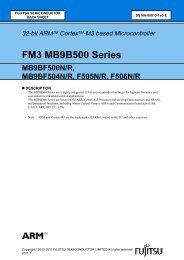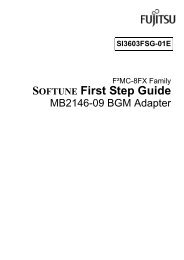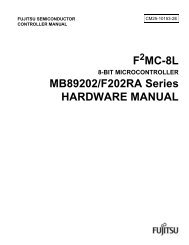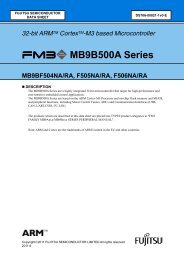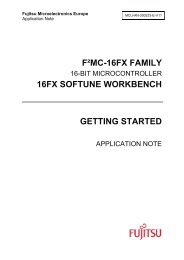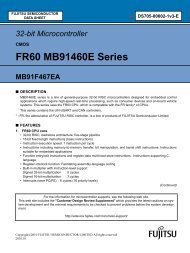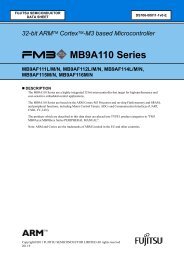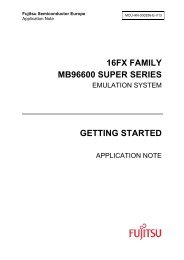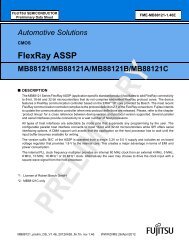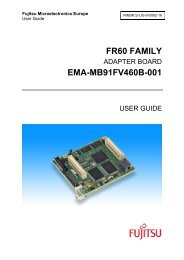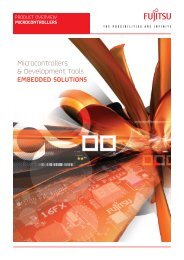MB96340 SERIES - Microcontrollers - Fujitsu
MB96340 SERIES - Microcontrollers - Fujitsu
MB96340 SERIES - Microcontrollers - Fujitsu
Create successful ePaper yourself
Turn your PDF publications into a flip-book with our unique Google optimized e-Paper software.
<strong>Fujitsu</strong> Microelectronics Europe<br />
Functional Limitation Report<br />
CI-300035-E-V10<br />
16-BIT MICROCONTROLLER<br />
<strong>MB96340</strong> <strong>SERIES</strong><br />
FUNCTIONAL LIMITATION 16FXFL0047<br />
DATA FLASH WRITE COMMAND<br />
SEQUENCER<br />
2009-03-16
Revision History<br />
Revision History<br />
Date Issue<br />
2009-03-16 V1.0, Initial Version<br />
This document contains 8 pages.<br />
Abbreviations:<br />
FME <strong>Fujitsu</strong> Microelectronics Europe GmbH<br />
MCU Microcontroller
Contents<br />
Contents<br />
REVISION HISTORY............................................................................................................ 2<br />
CONTENTS .......................................................................................................................... 3<br />
1 PROBLEM DESCRIPTION .............................................................................................. 5<br />
2 PROBLEM CONDITIONS ................................................................................................ 5<br />
3 AFFECTED DEVICES...................................................................................................... 5<br />
4 ROOT CAUSE ................................................................................................................. 6<br />
4.1 Normal function ....................................................................................................... 6<br />
4.2 Wrong behaviour..................................................................................................... 6<br />
5 WORKAROUND .............................................................................................................. 7<br />
5.1 Direct Flash access (read/write) without write command sequencer........................ 7<br />
5.2 Writing to the Flash with write command sequencer................................................ 7<br />
6 CORRECTIVE ACTION BY FUJITSU.............................................................................. 8
Contents<br />
<strong>Fujitsu</strong> does not bear any warranty in the case this handling note is not fully<br />
observed.
1 Problem Description<br />
Chapter 1 Problem Description<br />
A problem was found in the Data Flash interface on some 16bit MCUs. The problem does<br />
not occur if the write command sequencer for the Data Flash is disabled. Part numbers are<br />
listed below. This problem is called ‘Data Flash write command sequencer Problem’.<br />
2 Problem Conditions<br />
Problem may occur if all of the following conditions are met:<br />
• Data is written to the Data Flash by using the “Flash write command sequencer”<br />
• The WERINT flag/interrupt function is used or Words are programmed<br />
• A setting for DFCSA:TMG[2:0] is selected which is not valid for command sequencer<br />
writing at the current CLKB frequency (according to Table 2 below)<br />
3 Affected Devices<br />
The following devices are affected:<br />
• MB96F345DSA/ MB96F345DWA/MB96F345FSA/MB96F345FWA/ (all date codes)
4 Root Cause<br />
4.1 Normal function<br />
Chapter 4 Root Cause<br />
The Data Flash interface includes a “write command sequencer” which automatically<br />
submits the command sequence for Flash writing and which checks the progress of the<br />
Flash write operation. Status flags and interrupts inform the CPU or DMA if writing has<br />
terminated successfully or with an error.<br />
The write command sequencer identifies the termination of a write command by waiting for<br />
DFCSA:RDY=1. Afterwards the write command sequencer performs a read access to the<br />
programmed address to verify if the correct data was written to the Flash (“program verify<br />
access”)<br />
If the read data differs from the written data, then the DFWSA:WERINT write error flag will<br />
be set. If such a write error occurs at writing the first byte of a Word, then writing the second<br />
byte will be cancelled.<br />
The write command sequencer is performing read and write accesses with the timing<br />
defined by the DFCSA:TMG[2:0] bits. For each timing setting, a certain maximum CLKB<br />
frequency is defined in the HWM:<br />
Table 1: Definition of Data Flash timing bits according to Hardware manual<br />
4.2 Wrong behaviour<br />
At the “program verify access”, the write command sequencer samples the output data from<br />
the Flash one clock cycle too early. If the CLKB clock frequency is relatively high compared<br />
to the maximum permitted CLKB frequency stated in the table above, then wrong data can<br />
be sampled.<br />
In such a case, the DFWSA:WERINT flag will wrongly be set and can cause an error<br />
interrupt. If this happens at writing the first byte of a Word, then the second byte will not be<br />
written at all.<br />
The following chapters describes up to which CLKB frequency the write command<br />
sequencer is able to correctly perform the “program verify access”.
5 Workaround<br />
Chapter 5 Workaround<br />
5.1 Direct Flash access (read/write) without write command sequencer<br />
There is no limitation when reading the Flash by CPU or DMA or when writing to the Flash<br />
without the write command sequencer (DFWCA:WE=0).<br />
5.2 Writing to the Flash with write command sequencer<br />
Before writing to the Flash with the write command sequencer, the DFCSA:TMG[2:0] bits<br />
must be set according to the following table:<br />
Table 2: Maximum permitted frequencies for writing with command sequencer<br />
TMG2 TMG1 TMG0<br />
Max CLKB frequency<br />
for writing with write<br />
command sequencer<br />
Max CLKB frequency for<br />
reading or for writing without<br />
write command sequencer<br />
(as in Hardware manual)<br />
CLKB<br />
wait<br />
cycles<br />
(read)<br />
0 0 0 3 MHz 7.5 MHz 2 2<br />
0 0 1 6 MHz 16 MHz 3 2<br />
0 1 0 13 MHz 33 MHz 4 2<br />
0 1 1 20 MHz 50 MHz 5 2<br />
1 0 0 33 MHz 66 MHz 7 3<br />
1 0 1 40 MHz 83 MHz 8 4<br />
1 1 0 46 MHz 100 MHz 9 5<br />
1 1 1 100 MHz 100 MHz 10 5<br />
After termination of the write command, the DFCSA:TMG[2:0] bits can be switched back to a<br />
setting with less wait cycles if the smaller number of wait cycles are required for performance<br />
reasons.<br />
CLKB<br />
wait<br />
cycles<br />
(write)
6 Corrective action by <strong>Fujitsu</strong><br />
Chapter 6 Corrective action by <strong>Fujitsu</strong><br />
<strong>Fujitsu</strong> will correct this problem by a redesign of the Data Flash write command sequencer<br />
New part numbers are as follows:<br />
• MB96FxxxxxA MB96FxxxxxB<br />
Redesigns are scheduled as follows:<br />
• MB96F345<br />
o ES: 10th June 2009 (shipment)<br />
o CS: 4th Sept 2009 (shipment)


